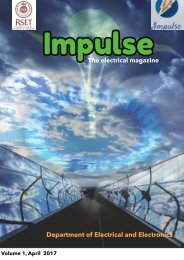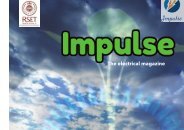impulse-ed 2-060417
Create successful ePaper yourself
Turn your PDF publications into a flip-book with our unique Google optimized e-Paper software.
IMPULSE 2017<br />
DEE, RSET<br />
been progress<strong>ed</strong> and this paper aims to depict the state of the art of SMC with SC. We will use<br />
the same categories as in Section III to summarize the developments.<br />
As has been stat<strong>ed</strong> before, the integration of SMC and SC has two dimensions. One is the<br />
application of SC technologies in SMC to make it “smarter” and the other using SMC to enhance<br />
SC capabilities. This survey will be confin<strong>ed</strong> within the scope of the former, i.e., the application<br />
of SC technologies in SMC.<br />
SMC WITH PR<br />
One PR technology commonly us<strong>ed</strong> in SMC is the EC for optimization. Another area is the<br />
application of chaos theory in SMC. We shall discuss their applications in SMC in the following.<br />
SMC WITH EC:<br />
The optimization of the control parameters and the model parameters are vitally important in<br />
r<strong>ed</strong>ucing chattering and improving robustness. In this respect, various optimization techniques can<br />
be us<strong>ed</strong> such as the gradient-bas<strong>ed</strong> search, Levenberg–Marquart algorithm, etc.; however, a<br />
significant amount of information about the tendency of search parameters toward optima (i.e., the<br />
derivative information) is requir<strong>ed</strong>. The complexity of the problem and the sheer number of<br />
parameters make the application of the conventional search methods rather hard. The key process<br />
of using EC is to treat the set of parameters (often a large number) as the attributes of an individual<br />
in a population and generate enough number of individuals randomly to ensure a rich diversity of<br />
“genes” in the population, through bio inspir<strong>ed</strong> operations such as mutation and/or crossover. The<br />
advantages previously mention<strong>ed</strong> has motivat<strong>ed</strong> various researchers to use EC as an alternative to<br />
find “optimal” solutions for SMC.<br />
SMC with Integrat<strong>ed</strong> NN, FL, and EC<br />
It is recogniz<strong>ed</strong> that NNs and EC are processes that enable learning and optimization while the<br />
fuzzy systems are a representation tool .For complex systems which are difficult to model and<br />
represent in an analytic form, it is certainly advantageous to use fuzzy systems as a paradigm to<br />
represent the complex systems as an aggregat<strong>ed</strong> set of simpler models, just like the role of local<br />
linearization plays in nonlinear function approximation by piecing together locally lineariz<strong>ed</strong><br />
models. NNs on the other hand can be us<strong>ed</strong> as a learning mechanism to learn the dynamics while<br />
the EC approaches can be us<strong>ed</strong> to optimize the representation and learning. Such ideas have been<br />
us<strong>ed</strong> quite extensively in dynamic systems and control areas. Research works in this area include<br />
two fuzzy NNs are us<strong>ed</strong> to learn the control as well as identify the uncertainties to eliminate<br />
chattering in distribut<strong>ed</strong> control systems. The conventional BP-bas<strong>ed</strong> learning mechanism can be<br />
employ<strong>ed</strong> for learning.<br />
Ms. RINU ALICE KOSHY<br />
ASST.PROFESSOR, DEE




